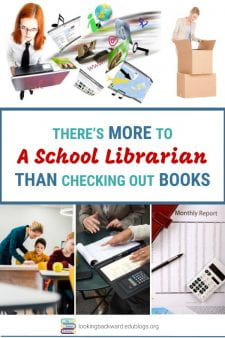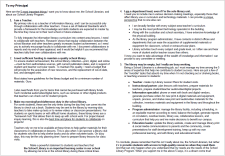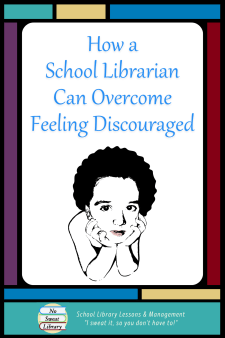 Our School Librarian listservs and Facebook groups are generally upbeat, but at times, one sees a post expressing job frustration because teachers and administrators don’t understand what we do. Invariably, our peers give us a virtual hug, along with some thoughtful suggestions that do help.
Our School Librarian listservs and Facebook groups are generally upbeat, but at times, one sees a post expressing job frustration because teachers and administrators don’t understand what we do. Invariably, our peers give us a virtual hug, along with some thoughtful suggestions that do help.
We are especially sympathetic when a new School Librarian becomes disillusioned, feeling worthless in their new role. Many School Librarians do feel discouraged, especially the first year or two after moving from classroom to library, because it’s just not what we expected it to be. Hopefully I can encourage you newbies by clarifying why you may be feeling this way. And for you veterans, maybe this “bigger picture” will remind you why you decided to leave the classroom and become the most valuable teacher in the school!
THE TEACHING DIFFERENCE
After becoming a School Librarian, I came to realize the big difference between being a school librarian and being a high school science teacher is jurisdiction—that is, having authority over our classroom instruction. Even with federal, state, or district requirements, a classroom teacher decides what to teach, when to teach, and how to teach on a daily basis.
Often School Librarians are not viewed as teachers—we’re seen merely as book caretakers. Most educators don’t know about our National School Library Standards or our information literacy curriculum, nor are they aware that we have a teaching degree and years of classroom experience before getting a library certification/degree. As a result, we are seen as expendable, and many schools no longer have a certified School Librarian.
It’s doubly hard when library information literacy skills are embedded into subject curricula without identifying them as such. Teaching these skills, then, looks like the responsibility of classroom teachers, who have no time—so they get ignored—nor the training to teach them properly. They just aren’t aware that we are trained to—and supposed to—integrate info-lit into their classroom activities. To paraphrase Tom Clancy, “If it isn’t written down it never happens,” so a School Librarian has to work extra hard to convince classroom teachers to collaborate on a library lesson visit.
Additionally, a classroom teacher has continual personal contact with students, with their learning, and with their assignments. As School Librarians, particularly at the secondary level with a flex schedule, we can’t really plan a learning “unit” as such. Instead, we teach haphazardly, rarely continuing through to the end of the teacher’s assignment, let alone having input on how it is assessed. As a result, we may try to cram as much information as possible into a single visit, which overloads the students and alienates the teacher.
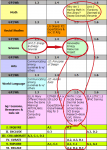 The solution to this is an information literacy curriculum matrix on which we can identify where to integrate skills into classroom activities and record which Standards are addressed. This handy tool allows a School Librarian to document National School Library Standards across subject areas and through grade levels so we cover them all by the time a student moves on to their next grade level building. As a result, lessons are more focused on specific learning objectives, are less overwhelming for students, and more gratifying for teachers…who then are eager to collaborate on future lessons.
The solution to this is an information literacy curriculum matrix on which we can identify where to integrate skills into classroom activities and record which Standards are addressed. This handy tool allows a School Librarian to document National School Library Standards across subject areas and through grade levels so we cover them all by the time a student moves on to their next grade level building. As a result, lessons are more focused on specific learning objectives, are less overwhelming for students, and more gratifying for teachers…who then are eager to collaborate on future lessons.
THE ROOM DIFFERENCE
Another big difference between a School Librarian and a classroom teacher is dominion—having authority over our own “classroom” domain. Unless a school is particularly pressed for space, no one else uses a teacher’s assigned room, so they have complete control over it. Au contraire the school library! Because of its size and layout—and being cozier than the cafeteria or gym—the school library is frequently appropriated for meetings, professional development, and special events, as well as student testing, guest speakers, and presentations.
No one hesitates about using the school library for their needs, and all too often they don’t think to notify, or even ask, the librarian. What is unthinkable for a classroom teacher is a common occurrence with every School Librarian. Many an afternoon a teacher or administrator would enter my library and begin moving things around to set up for their event the next day, and I’d have to scramble to make alternative arrangements for the groups of students I’d planned to have in for lessons.
Such occurrences are why a School Librarian can ask to be in charge of the print and online school event calendar, so folks have to consult with us about any event in the school. Not only does this help immensely for scheduling library use, it also gives us an “in” for taking photos or videos to add to the school and library websites.
THE ROLE DIFFERENCE
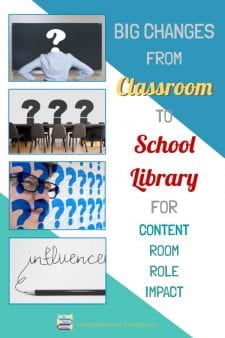 A third big difference between a School Librarian and a classroom teacher is power—having authority over our daily activity. It may seem that we have no control at all over what we do in the school library. This is the downside of our job—and what is often the cause of our discouragement. We’re “always on call”, and everyone is unconcerned if we’ve made our own plans. Many of us have ‘assigned’ time periods with students that limits the time we can spend on library administrative tasks. We’re treated somewhere between a sub and an aide—until we accomplish some feat of wizardry, and then we’re regarded as a genius and everyone wants us to help them accomplish the same thing in the 5 minutes between their phone call to us and when their class starts. Along with all that, we need to now know everyone’s curriculum and the entire print & digital library collection, supplying relevant resources when asked for at the drop of a hat.
A third big difference between a School Librarian and a classroom teacher is power—having authority over our daily activity. It may seem that we have no control at all over what we do in the school library. This is the downside of our job—and what is often the cause of our discouragement. We’re “always on call”, and everyone is unconcerned if we’ve made our own plans. Many of us have ‘assigned’ time periods with students that limits the time we can spend on library administrative tasks. We’re treated somewhere between a sub and an aide—until we accomplish some feat of wizardry, and then we’re regarded as a genius and everyone wants us to help them accomplish the same thing in the 5 minutes between their phone call to us and when their class starts. Along with all that, we need to now know everyone’s curriculum and the entire print & digital library collection, supplying relevant resources when asked for at the drop of a hat.
On the other hand, the upside of our job is that we do have more control over what we do and when. In the classroom we had one role: a content-area teacher with a prescribed curriculum. Not so as a School Librarian. We must be the supreme multi-tasker: a secretary, a custodian, a curriculum specialist, a tech whiz, an accountant, an audio/video engineer, a babysitter, a therapist, and a diplomat, and in between still a teacher. We surely are never bored with the ‘same ole thing.’
The School Librarian can be a true renaissance person, expanding into every avenue of education and technology, finding personal satisfaction in our own accomplishments, and knowing that it will take at least 5 people to replace us. We can strive, daily, to make the library a Knowledge Production Center—the place students come to for creating audio, video, digital, and designed work products, and where teachers come begging to help them learn and integrate!
FINDING OUR NICHE
I’m still convinced that other educators will gradually “get it,” that eventually they’ll realize the information & media literacy knowledge and skills learned from the School Librarian are important to our children’s futures, more than just about any other thing they learn in school.
While waiting for that time, we can trade jurisdiction and dominion for influence: becoming a compelling force on the actions, opinions, and behavior of everyone in our sphere. We can slowly turn each teacher, student, and administrator into viewing us as the most indispensable person in the building. That’s an incredibly impactful vocation!
It took until my 5th year as a librarian to master library administration and to convince colleagues that “I really am a teacher.” For those who find they don’t like school librarianship, there’s nothing wrong with going back to the classroom. We all need to find our niche, and having tried something that doesn’t quite fit should not be disappointing—it’s actually a giant step on the road to self-actualization.
I remember in one of my MLIS courses a couple teachers were retiring from the classroom to become librarians because it’s ‘easier’. Of course, we who had already begun as librarians laughed uproariously—this is the hardest job we’ve ever had! But thankfully, it’s also the most rewarding job we’ve ever had when we focus on what we’ve gained: flexibility and autonomy. Actually, it might be good for librarians to periodically spend some time back in the classroom, just to keep fresh and remember why we changed jobs, although who they’d get to cover for us is beyond me!
![]()
Updated & changed from 2015.




 To ensure student achievement, the school library collection—print, digital, and online—must be from authoritative sources, with current publication dates, and in support of student and teacher curricular needs. To maintain this quality, I need a budget that will provide for the acquisition of new resources and the replacement of out-of-date, lost, and damaged ones.
To ensure student achievement, the school library collection—print, digital, and online—must be from authoritative sources, with current publication dates, and in support of student and teacher curricular needs. To maintain this quality, I need a budget that will provide for the acquisition of new resources and the replacement of out-of-date, lost, and damaged ones.
